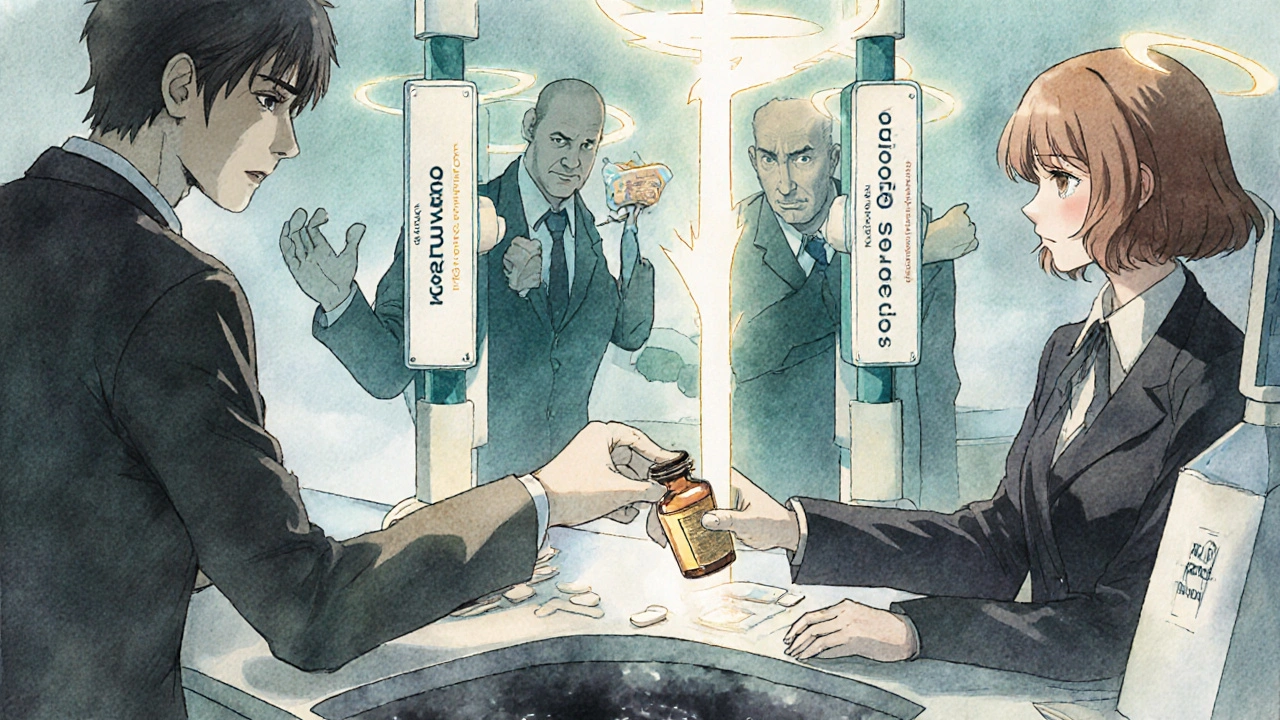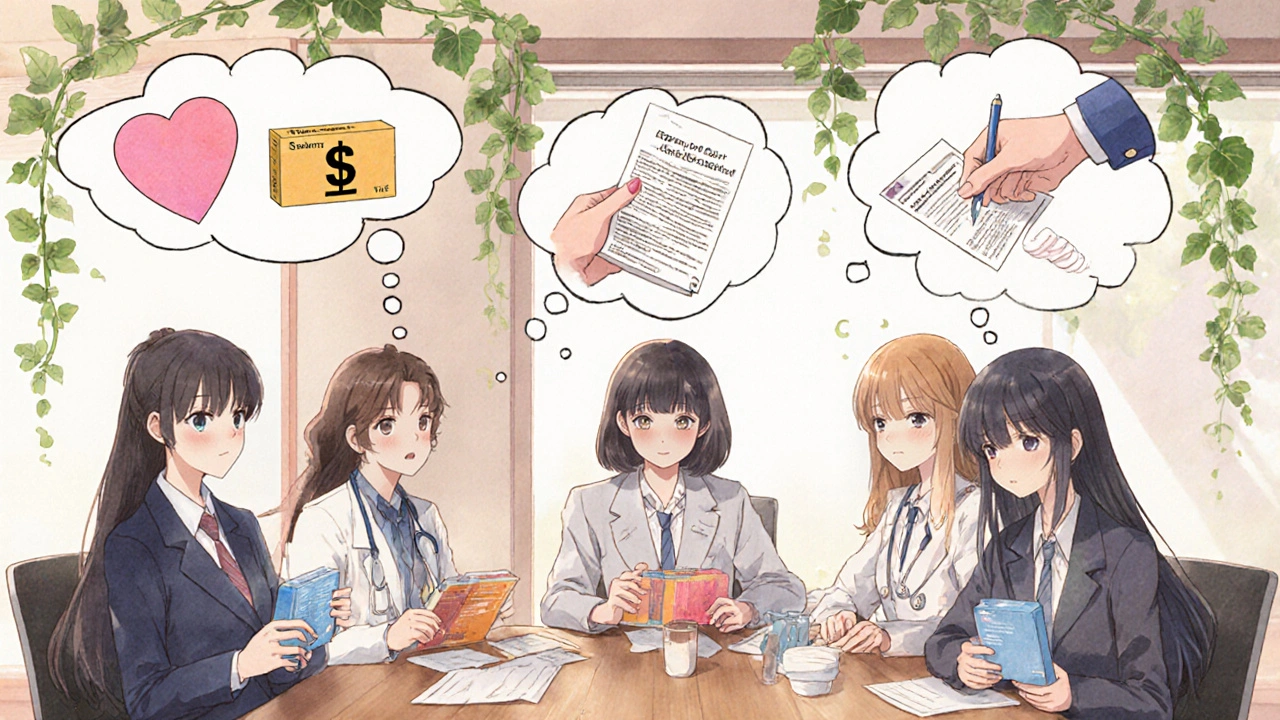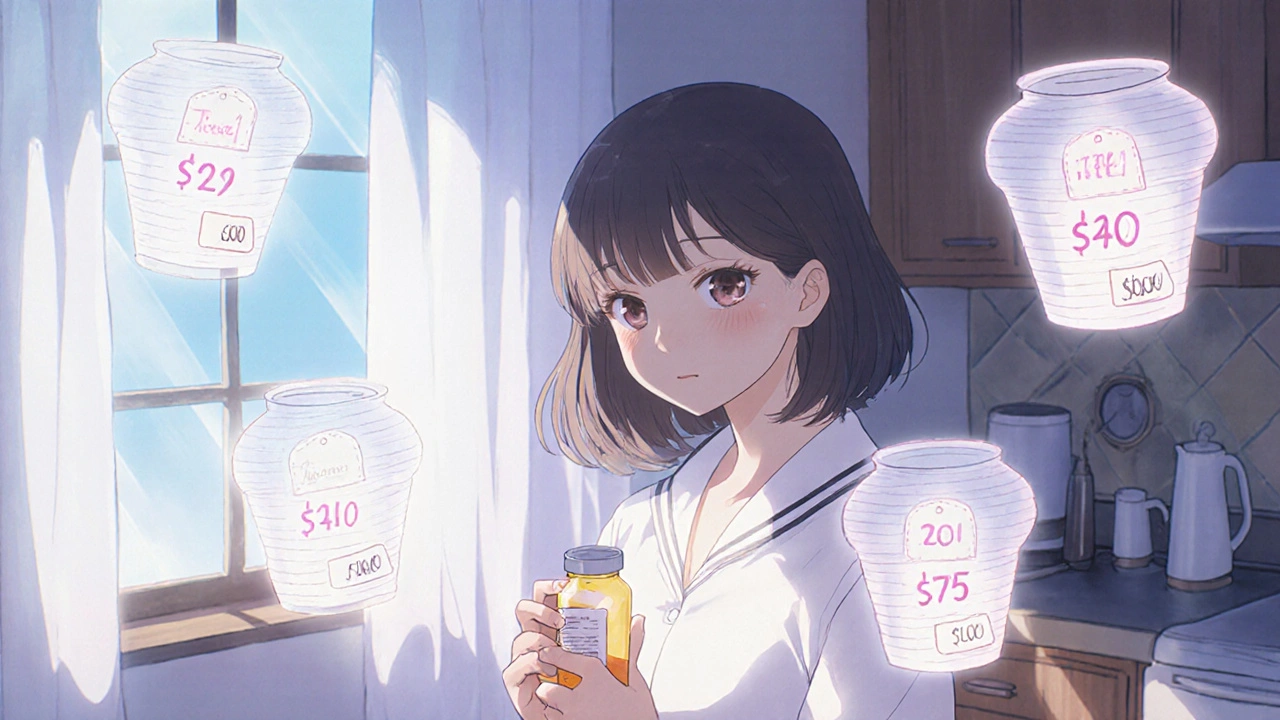When you pick up a prescription at the pharmacy, you might not realize that the price you pay isn’t just about the drug-it’s shaped by a hidden system called a formulary. This is the list your employer’s health plan uses to decide which medications are covered, and how much you’ll pay out of pocket. Most large employers use tiered formularies that strongly favor generic drugs, not because they’re less effective, but because they save money-big time.
Why Your Employer Pushes Generic Drugs
Generic medications aren’t cheap knockoffs. They’re exact copies of brand-name drugs, approved by the FDA as equally safe and effective. The only real difference? Price. Generics cost 80-85% less because they don’t need to repeat expensive clinical trials or run nationwide ad campaigns. That’s why your employer’s health plan pushes them hard.In 2023, generic drugs saved the U.S. healthcare system over $150 billion in a single year. That’s $3 billion every week. For employers, that’s not just a nice saving-it’s a necessity. Rising drug costs have forced companies to rethink how they offer health benefits. One of the most effective tools? Making generics the default option.
Most employer plans structure coverage in tiers. Tier 1 is almost always reserved for generics. If your prescription is on Tier 1, you might pay just $10 per fill. Tier 2 might be preferred brand-name drugs, costing $40. Tier 3? Non-preferred brands, $75 or more. And Tier 4? That’s for specialty drugs-like those for diabetes, arthritis, or cancer-and those can cost hundreds per month.
How Formularies Work Behind the Scenes
Your plan’s formulary isn’t static. It changes often. When a brand-name drug loses its patent and a generic hits the market, the Pharmacy Benefit Manager (PBM)-the middleman that handles drug coverage for your employer-automatically moves the generic to Tier 1 and the brand version to Tier 4. Suddenly, the same medication you’ve been taking costs seven times more.For example, if you’ve been on a brand-name blood pressure pill for years, and a generic becomes available, your copay could jump from $40 to $75 overnight. If you don’t switch, you’re paying more-not because the drug changed, but because the system is designed to nudge you toward the cheaper option.
Three PBMs-OptumRx, CVS Caremark, and Express Scripts-control nearly all employer prescription plans in the U.S. These companies don’t just manage claims. They decide which drugs make the list and which get cut. In January 2024, each of these three PBMs removed over 600 drugs from their formularies. That’s more than 1,800 medications taken off coverage in a single month. Why? To pressure drugmakers into offering bigger discounts.
The Hidden Gap: Why Savings Don’t Always Reach You
Here’s where it gets complicated. PBMs negotiate rebates from drugmakers. These are discounts they get after the drug is sold. But here’s the catch: those rebates don’t always go to you, the patient. The difference between the drug’s list price and what the PBM actually pays after rebates is called the gross-to-net (GTN) spread. On average, it’s 55%. That means a drug might be priced at $100, but the PBM pays just $45 after rebates. The rest? Kept by the PBM or used to lower premiums for the employer.So even though your plan saves money because of generics and rebates, your copay might not drop. In fact, you might still be paying the same $10 for a generic-even though the real cost to the plan is now only $3. The savings stay inside the system, not in your wallet.
This disconnect frustrates many employees. They’re told generics save money, but they don’t see it in their paychecks. Employers, meanwhile, are pressured to keep premiums low. The result? A system that works for the company’s budget-but doesn’t always feel fair to the employee.

What to Do If Your Medication Gets Removed
If you open your prescription bottle one day and find your drug is no longer covered, don’t panic. First, check your plan’s formulary online. Most insurers have searchable drug lists under “Pharmacy Benefits” or “Formulary.” Look up your medication by name. If it’s not there, your plan likely excluded it.Next, call your insurer. Ask: “Is there a generic alternative?” If yes, ask if you can switch. If no, ask about a medical necessity exception. Your doctor can submit a request explaining why you need the brand-name drug-for example, if you had a bad reaction to the generic, or if it’s not as effective for your condition.
Some employers offer care management programs. These are dedicated staff who help employees find affordable alternatives, apply for patient assistance programs, or navigate prior authorizations. Ask your HR department if your plan includes one.
How to Stay in Control of Your Coverage
You can’t control your employer’s formulary, but you can control how you respond to it. Here’s how:- Check your formulary every time you refill a prescription. Changes happen without notice.
- Ask your pharmacist: “Is there a generic version?” They often know before you do.
- Use in-network pharmacies. Some plans offer automatic discounts on generics only through certain pharmacies.
- Review your Summary of Benefits and Coverage (SBC) every year during open enrollment. It’s not just about premiums-drug tiers matter just as much.
- If you take multiple prescriptions, ask your doctor about combination pills or alternatives that fall into lower tiers.
Don’t assume your doctor knows what’s covered. Many doctors still default to prescribing brand names because they’re familiar with them. Bring up generics yourself. Say: “I’d like to try the generic if it’s just as good. Can we switch?”

When Generics Aren’t Enough
Some conditions require specialty drugs-like biologics for rheumatoid arthritis or insulin for type 1 diabetes. These drugs don’t have true generics; instead, they have biosimilars, which are similar but not identical. These are often placed in Tier 4 and come with high copays.For chronic conditions, some employers offer special programs. For example, HealthOptions.org’s Chronic Illness Support Program helps members find lower-cost options, get free delivery, or apply for financial aid. Ask your HR team if your plan has something similar.
If you’re paying over $100 a month for a medication and can’t switch to a cheaper alternative, ask your doctor about manufacturer coupons or patient assistance programs. Many drugmakers offer free or discounted meds to people who qualify based on income.
The Bigger Picture
Employer health plans aren’t trying to trick you. They’re trying to survive. Drug prices keep rising, and without formularies, premiums would climb even faster. The goal is to keep coverage affordable for everyone.But the system is broken in one key way: the people who pay the most-employees-don’t always see the savings. That’s why transparency is the next big frontier. Some states are starting to require PBMs to pass rebates directly to consumers. Employers are beginning to demand more accountability from their PBM contracts.
For now, the best strategy is simple: know your formulary. Ask questions. Don’t accept the first price you’re given. And remember-generics aren’t second-rate. They’re smart, safe, and proven. If your plan pushes you toward one, it’s not a limitation. It’s a chance to save money without sacrificing care.
Are generic drugs really as good as brand-name drugs?
Yes. The FDA requires generic drugs to have the same active ingredients, strength, dosage form, and route of administration as the brand-name version. They must also meet the same strict standards for safety, purity, and effectiveness. The only differences are in inactive ingredients (like fillers or dyes) and cost. Generics are not cheaper because they’re lower quality-they’re cheaper because manufacturers don’t repeat expensive clinical trials.
Why does my copay go up when a generic becomes available?
It doesn’t-unless you’re still taking the brand-name version. When a generic is approved, the PBM moves the brand-name drug to a higher tier (like Tier 4) and puts the generic in Tier 1. Your copay for the brand may jump from $40 to $75 or more. But if you switch to the generic, your cost drops to $10. The system is designed to make the cheaper option the easiest and most affordable one.
Can my employer change my drug coverage anytime?
Yes. Formularies can change at any time, often without advance notice. This is especially true when new generics enter the market or when PBMs renegotiate contracts with drugmakers. That’s why it’s important to check your plan’s drug list before refilling prescriptions, especially if you’re on a long-term medication.
What if my medication is removed from the formulary?
You have options. First, ask if there’s a generic or biosimilar alternative. If not, ask your doctor to file a medical necessity exception with your insurer. This is a formal request that explains why you need the specific drug-for example, because you had side effects with alternatives. Many exceptions are approved, especially for chronic conditions.
Do PBMs keep the savings from rebates instead of passing them to me?
Often, yes. PBMs negotiate rebates from drugmakers, but those savings don’t always go to you. The difference between the drug’s list price and the net price after rebates-called the GTN spread-can be as high as 55%. That money may go to the PBM, the employer, or be used to lower premiums. Unless your plan is structured to pass rebates directly to members, you won’t see the full benefit.
How can I find out what drugs my plan covers?
Visit your insurer’s website and look for “Formulary,” “Drug List,” or “Pharmacy Benefits.” You can search by drug name. You can also check your Summary of Benefits and Coverage (SBC), which is sent to you during open enrollment. If you’re unsure, call the customer service number on your insurance card and ask for the current drug list.
Are there programs to help me afford my medications?
Yes. Many employers offer care management programs that help you find lower-cost alternatives, apply for patient assistance from drugmakers, or get free delivery. Drug manufacturers also have their own programs for low-income patients. Your pharmacist can help you find them. Don’t assume you can’t afford your meds-there’s often help available.


Andy Slack
November 9, 2025 AT 19:41Generics saved me $200/month on my cholesterol med. I was skeptical at first, but after 6 months, my labs were identical. My doctor even said, 'Why pay more if it does the same thing?' The system's not perfect, but generics are the quiet hero of American healthcare.
Rashmi Mohapatra
November 10, 2025 AT 01:47lol so u mean i pay 10$ for same drug my friend in india pays 2$ for? 🤡
Abigail Chrisma
November 10, 2025 AT 21:53Thank you for breaking this down so clearly. I used to think generics were 'second choice' meds until my dad switched to one after his heart attack and had zero issues. The system is rigged, yes-but knowing how to navigate it is power. Always ask your pharmacist. They know the real scoop.
Ankit Yadav
November 12, 2025 AT 12:39My formulary changed last month and my asthma inhaler went from $15 to $90 overnight. Called my insurer, asked for the generic alternative, got it approved in 2 days. No drama. Just ask. It's not that hard
Meghan Rose
November 13, 2025 AT 02:48Wait so you're telling me I'm paying $10 for a pill that costs $3 to make and the company pockets $7? That's not savings, that's exploitation. And don't even get me started on how PBMs get kickbacks from drugmakers to keep brand names on the list. This system is a joke.
Steve Phillips
November 14, 2025 AT 21:05Oh, so now we’re supposed to be *grateful* that our employers are squeezing us for profit while pretending it’s ‘for our benefit’? The PBM cartel is a modern-day monopoly disguised as ‘efficiency.’ They’re not saving you money-they’re gaming the system so your copay stays the same while their bonuses skyrocket. This isn’t healthcare-it’s financial theater.
Rachel Puno
November 16, 2025 AT 05:12My sister has type 1 diabetes and her insulin used to cost $400 a month. She switched to a biosimilar through her employer’s program and now pays $35. It’s not perfect, but it’s life-changing. Don’t give up. Talk to HR. Ask for help. There’s always a path.
Clyde Verdin Jr
November 16, 2025 AT 23:26Y’all are acting like this is some noble cost-saving measure. Nah. It’s corporate greed wrapped in a lab coat. My mom got switched to a generic that gave her migraines. She had to fight for 3 months just to get her original med back. They don’t care if you suffer-they care about their bottom line. 😭
Key Davis
November 17, 2025 AT 14:50It is imperative to recognize that the structural dynamics of pharmacy benefit management are deeply embedded within the broader economic framework of American healthcare delivery. The disparity between gross and net pricing, while statistically significant, must be contextualized within the fiduciary responsibilities of employers to maintain sustainable benefit packages. Transparency and regulatory oversight are not merely desirable-they are ethically obligatory.
Cris Ceceris
November 19, 2025 AT 00:38I wonder if the real question isn’t whether generics work-but whether we’ve normalized being treated like line items in a spreadsheet. We’re told to be grateful for savings we never see, while the people who set the rules never feel the pinch. Maybe the system isn’t broken… maybe it was designed this way. And if so… who’s really paying the price?